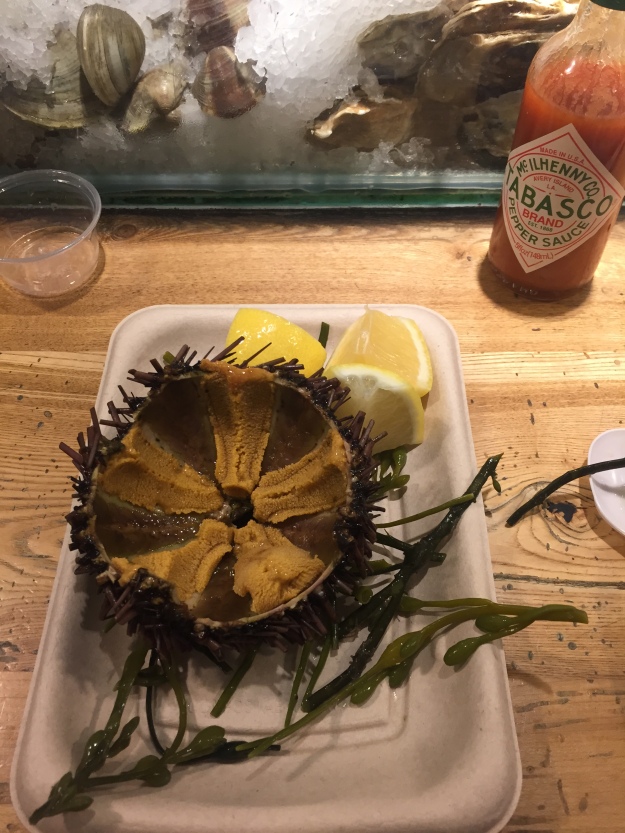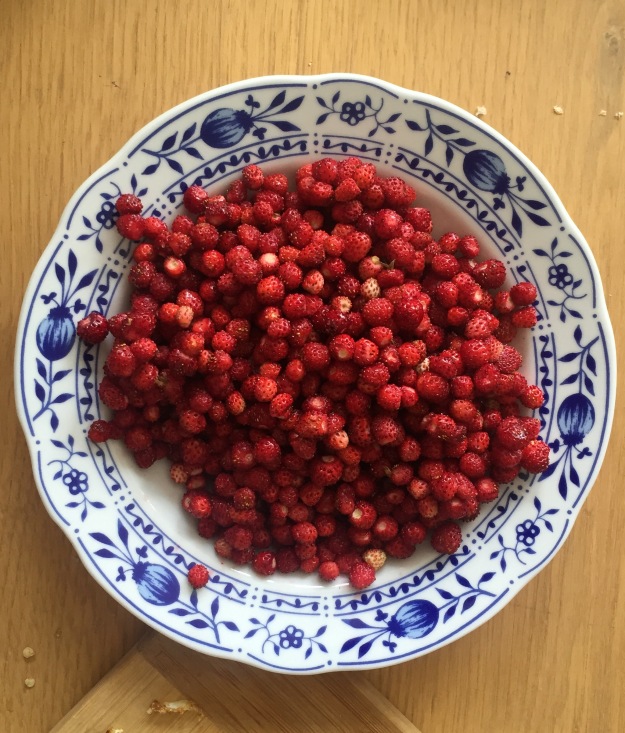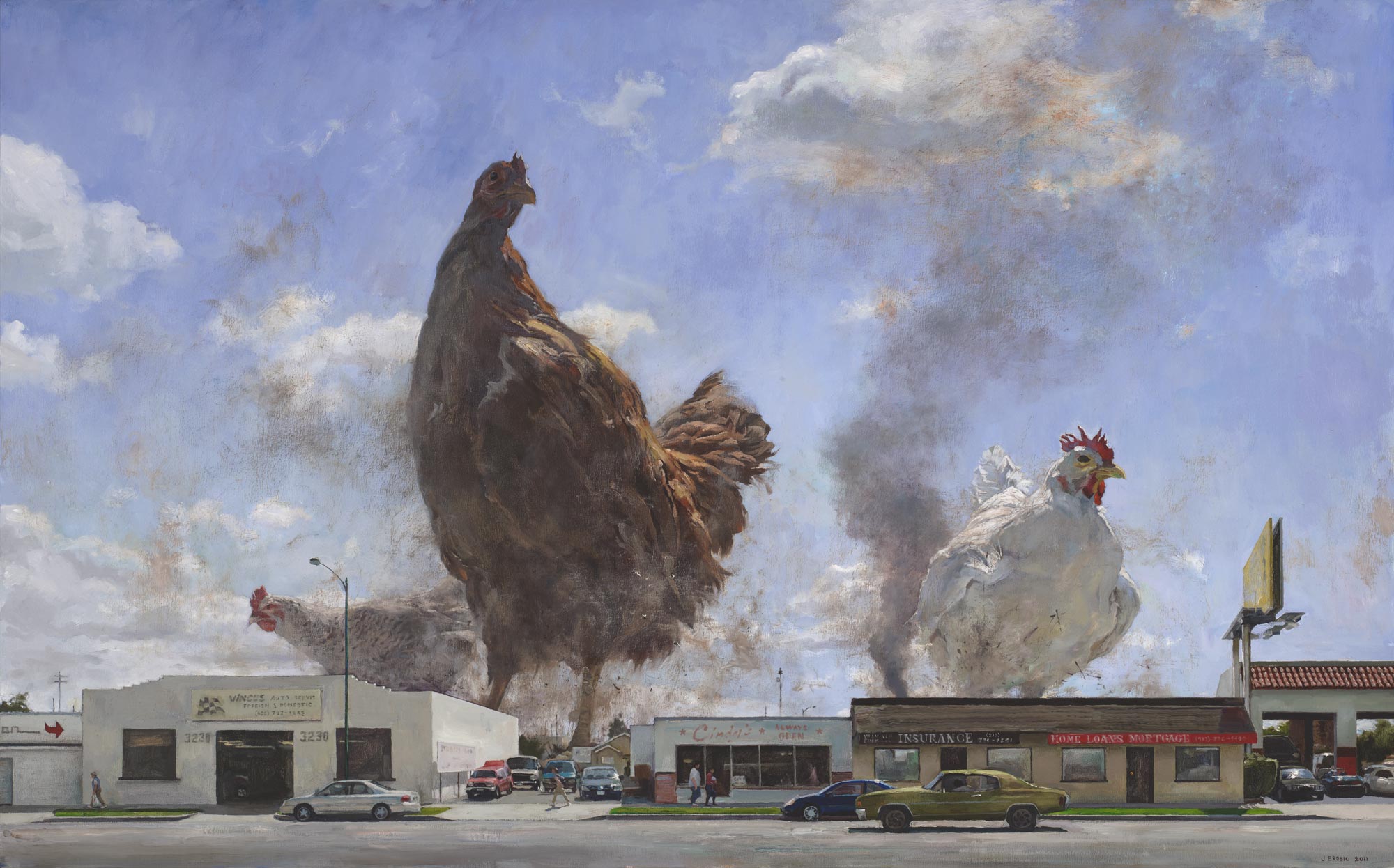29. VIII 2017
Tartuffe di mare
Microcosmus Sabatieri is a species of tunicates, sea squirts or, more properly, ascidians, also known as Sea violet, Biju, Patate de mer, Stronzi di mare, Tartuffe di mare, Limone di mare, Fouska, Sea fig or Sea egg, they are found in shallow waters along the Mediterranean coast.
Shaped like a large potato, blackish-brown in color on the outside, they are covered with epibiotes (fixed organisms), hence their Latin name Microcosmus. They take in sea water through a top siphon and eject it through a side siphon. As it passes through, a branchial structure retains the vegetable and animal micro-organisms necessary for its nutrition, as well as oxygen. They range in size from 15-20 cm on average.

All species of Microcosmus are edible, but it is mainly Microcosmus Sabatieri which is used as food in parts of Southern Europe, such as France, Italy, Greece, Croatia or Montenegro. The tunic is thick and tough on all the commonly consumed species and is usually removed before preparation. When you cut through it with a knife, inside looks line numerous yellow pockets with reddish boundaries — each looks like an open sore. It is eaten raw, often with an acidic condiment such as lemon juice or vinegar with shallots. It has a strong iodine taste which might not appeal to everyone.
The taste is very crisp and fresh with a distinct flavor of the sea — exactly what you would expect from a freshly caught seafood. It is more extreme than oysters or sea urchins, but it is like neither. High concentration of iodine cuts through a strong briny mix pushing it to the boundaries of bitter, not over it, but very close. It is an absolute concentrate of the sea. Brine is dialed up (to 11) and what is only hinted by oysters and sea urchins, is pushed to the limits here; nothing is held back – you can’t go any further, the road stops right there.
For about 20 minutes after sucking out half a dozen of these pockets, I felt a light buzz, and my lips went slightly numb, as when the dentist applies a light anesthetic over them to neutralize the pinch of a needle.
I have never eaten oysters or sea urchins where, at the end, I felt like I couldn’t have a few more. Well, with these guys, after eating six of them, there was no room for more. I had no doubt.
1. II 2017
Uni
There is no middle ground when it comes to eating sea urchins (uni). It is a love or hate kind of thing. Its taste (a rich and creamy aphrodisiac seasoned by the salinity of the ocean), and looks (resembles a poodle shit), leaves no one indifferent — from utter disgust to absolute surrender. Uni has unmistakably erotic overtones. Eating Uni is like going down on a mermaid is probably the best summary of that experience; although a non-existent act, ex-post our minds have no difficulty imagining it.
A lot of people commonly mistake uni as being the roe (eggs) of the shellfish. In reality, that’s not far off but they’re actually its gonads (aka sexual reproductive organs, of which each sea urchin has 5 total). This makes the mermaid comparison not very far fetched and almost appropriate .

Sea urchin at Chelsea Market
To say that sea urchins taste of the sea doesn’t do justice to this delicacy. They are sweet, deep, and complex, and have an unmistakably pure flavor. Live uni, taken directly from a living sea urchin, is a much different experience, in terms of texture and flavor, than its sushi counterpart. Fresh uni taste is much more rounded, balanced and without rough edges (almost buttery) than the one that was processed (at least) 24+ hours beforehand, where certain chemical reactions have been underway and the iodine often resurfaces as the dominant component.
There are hundreds of different varieties found in every ocean around the world, but only 18 are edible. In the US, the most prevalent varieties originate from Santa Barbara, California (like the one in the picture), Maine, and Hokkaido. The latest craze among European and Scandinavian chefs is Norwegian Greens, also known as Crow’s Balls by locals in Northern Norway. These urchins are handpicked in the deep, frigid waters off the coast of a small town called Bodø, located some 300 km into the Arctic Circle.
It is said that savouring uni can induce euphoria. If you eat enough (really, a lot) of them, you may find yourself totally stoned. Anandamide, the chemical found in the roe of sea urchins, is very similar to THC, the primary psychoactive chemical found in cannabis.
28. VIII 2016
Wild strawberries
Wild strawberry (fragaria vesca), Alpine strawberry, or fraise des bois. Once tasted, never forgotten. They have a concentrated taste of strawberries. As if berries of normal strawberry would shrink to 1/10 of their size, but keeping the same amount of taste.
Very difficult to come across in the US. One sees them sometime as decorative plants — Indian strawberries, the “mock” version of wild strawberries – similar look, but no taste or flavor. Compared with cultivated strawberries, the wild species have higher aroma intensities and significantly richer flavors, because they contain greater quantities of odorous molecules, including some extra ones.
In a comparison test between the cultivated variety Fragaria x ananassa Elsanta and the wild Fragaria vesca, scientists found that the cultivated strawberry contained only two terpenoid (highly aromatic) molecules but a wide range were present in the wild sample including a -pinene, beta-myrcene, alpha-terpineol and beta-phellandrene as well as myrtenyl acetate and myrtenol. These cause the smell of essential oils found in plants such as conifers and herbs such as myrtle and bay which all have strong aromas and flavors.

11. VI 2016
Belon oysters in Chelsea Market
They are here, and they are fantastic. Belon, the queen of oysters. True “Belons” come from the Belon River estuary in Brittany. Known as “The European Flat Oyster”, these large oysters were transplanted to Maine decades ago. While local legend has it that they came from Europe in the bilge of ships and took root here long before we were a country, in truth they were deliberate transplants by scientists to the Boothbay Region in the 1950s. Here they were able to adapt to survive in Maine’s cold waters and reproduce and establish various beds throughout the Maine coast.
The creamy to light brown meat of these oysters is plump and substantial, with a big, pronounced flavor and metallic, “coppery” finish – distinct minerally and far less briny than their Eastern Oyster cousins, with a “sweet to flinty” overtone.
There are many theories about wine pairing for oysters, Muscadet–Sèvre et Maine, Chablis, Champaign,… Nay! Alsatian Sylvaner is absolutely magical. Totally counterintuitive when drunk separately, but the match is just perfect.

30. V 2016
It’s a mushroom season
Porcini & morels

10. IV 2016
A commodity like no other
While imposing the globalization of agriculture on the Third World economies, developed countries are taking a great care to maintain their own food self-sufficiency. The West has never abandoned this policy and with systematic financial support for their own farmers (in Europe, this support accounts for more than half of the entire European budget), it is blatantly violating the free-market economy rules it is trying to impose globally. In this process, many countries are kept in a state of postcolonial dependence and are becoming increasingly vulnerable to market fluctuations (e.g. starvation in Haiti and Ethiopia as a consequence of higher prices of corn due to biofuel usage).
The following three examples give a sample of strategies that have been employed in the past. The methods range from outright bullying in the global markets, to stalling tactics when it comes to financial aid measures.
1) The bulk of the economy of the African county of Mali is based on two commodities, cotton in the south and cattle in the north. Mali produces top quality cotton. However, it can not compete on the global markets because the financial support of the US government to its own cotton farmers exceeds more than the entire state budget of Mali. The cattle industry suffers a similar handicap as the European Union’s subsidy for every single cow (around 500 Euros) is higher than GDP per capita of Mali.
2) West has been continuously pressuring African countries into dropping government subsidies for fertilizers, improved seed… Without subsidy, agriculture could no sustain itself based on the domestic market alone. In that way, the western pressures opened the way for the best land to be used for export crops ruining these countries’ capacity to be self-sufficient in food production. This led to integration of local agriculture into global economy: as more domestic crops were exported, countries had to rely increasingly on imported food while farmers thrown off their land were forced into slums, where the only work available was in outsourced sweatshops.
3) To put things into perspective in terms of scale, priorities and timing, compare $700bn spent on stabilization of the banking system in the US with $22bn pledged (by the rich nations) to help develop poorer nations’ agriculture, out of which only 1/10th ($2.2bn) has been made available so far.
The circle of postcolonial dependence is closing again
Systematic extension of these strategies is spreading globally with large international companies (from Korea, Saudi Arabia etc.) leasing long-term arable land in undeveloped areas. By investing in infrastructure, these companies will create jobs for the locals and, at the same time, secure the consumers for their products as they will spend that money on “imported” food farmed on their own land. The proponents of the new world order use this part to argue that the lack of food is in itself and indicator of progress, since people in fast developing third-world countries earn more and so can afford to eat more. However, this new demand causes withdrawal of supply from millions in the countries lacking such fast growth.
Unlike other commodities whose abundance or scarcity can be converted into quality of life upgrade or downgrade, basic resources like food, water and energy are a matter of survival whose absence at some point could have irreversible effects on the entire economy. The list of products and services which, like food, are not commodities like others extends further including defense, the environment as such, culture, education, health etc. Substantial fluctuations and otherwise normal market uncertainties in prices of these resources can not be tolerated and decisions regarding their accessibility can not be left to the market. By extension of this argument, the free market should be left to rule only inessential products (toys, cosmetics, clothing,…).
From production to rent economy and the growing scarcity premium of the basic resources
We are approaching a global state in which the potential scarcity of basic resources like energy, water and food, would become the determining factor in international politics. A proper approach to these problems can not be addressed as a short-term issue. It is unlikely to be handled by any regulations, but rather with a long-term agenda in mind and out of the realm of free-market economy.
With the advancement of technology, the production costs are likely to continue to decline, but the price of basic resources (like other technology related products) need not decline in tune with production costs (e.g. the price of oil does not reflect its production costs). Rather, the economy in this area will evolve from production to rent based. The consumers of the basic resources (in this case the entire planet) are likely to pay a rent premium to the owners of these resources and this scarcity premium is likely to continue to grow due to their diminishing supply.
